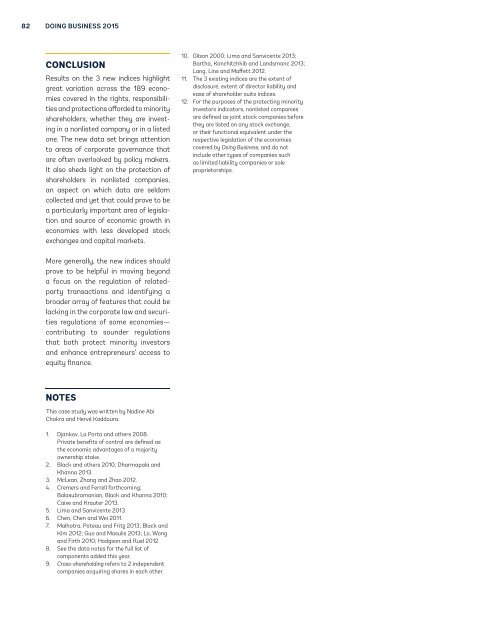bc8G2-7
bc8G2-7
bc8G2-7
Create successful ePaper yourself
Turn your PDF publications into a flip-book with our unique Google optimized e-Paper software.
82<br />
DOING BUSINESS 2015<br />
CONCLUSION<br />
Results on the 3 new indices highlight<br />
great variation across the 189 economies<br />
covered in the rights, responsibilities<br />
and protections afforded to minority<br />
shareholders, whether they are investing<br />
in a nonlisted company or in a listed<br />
one. The new data set brings attention<br />
to areas of corporate governance that<br />
are often overlooked by policy makers.<br />
It also sheds light on the protection of<br />
shareholders in nonlisted companies,<br />
an aspect on which data are seldom<br />
collected and yet that could prove to be<br />
a particularly important area of legislation<br />
and source of economic growth in<br />
economies with less developed stock<br />
exchanges and capital markets.<br />
10. Gilson 2000; Lima and Sanvicente 2013;<br />
Bartha, Konchitchkib and Landsmanc 2013;<br />
Lang, Lins and Maffett 2012.<br />
11. The 3 existing indices are the extent of<br />
disclosure, extent of director liability and<br />
ease of shareholder suits indices.<br />
12. For the purposes of the protecting minority<br />
investors indicators, nonlisted companies<br />
are defined as joint stock companies before<br />
they are listed on any stock exchange,<br />
or their functional equivalent under the<br />
respective legislation of the economies<br />
covered by Doing Business, and do not<br />
include other types of companies such<br />
as limited liability companies or sole<br />
proprietorships.<br />
More generally, the new indices should<br />
prove to be helpful in moving beyond<br />
a focus on the regulation of relatedparty<br />
transactions and identifying a<br />
broader array of features that could be<br />
lacking in the corporate law and securities<br />
regulations of some economies—<br />
contributing to sounder regulations<br />
that both protect minority investors<br />
and enhance entrepreneurs’ access to<br />
equity finance.<br />
NOTES<br />
This case study was written by Nadine Abi<br />
Chakra and Hervé Kaddoura.<br />
1. Djankov, La Porta and others 2008.<br />
Private benefits of control are defined as<br />
the economic advantages of a majority<br />
ownership stake.<br />
2. Black and others 2010; Dharmapala and<br />
Khanna 2013.<br />
3. McLean, Zhang and Zhao 2012.<br />
4. Cremers and Ferrell forthcoming;<br />
Balasubramanian, Black and Khanna 2010;<br />
Caixe and Krauter 2013.<br />
5. Lima and Sanvicente 2013.<br />
6. Chen, Chen and Wei 2011.<br />
7. Malhotra, Poteau and Fritz 2013; Black and<br />
Kim 2012; Guo and Masulis 2013; Lo, Wong<br />
and Firth 2010; Hodgson and Ruel 2012.<br />
8. See the data notes for the full list of<br />
components added this year.<br />
9. Cross-shareholding refers to 2 independent<br />
companies acquiring shares in each other.


